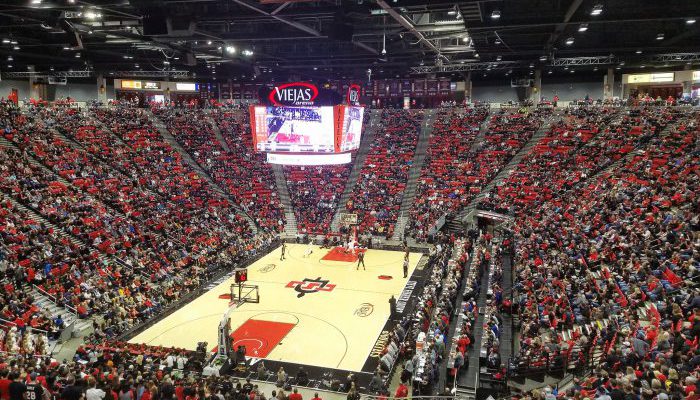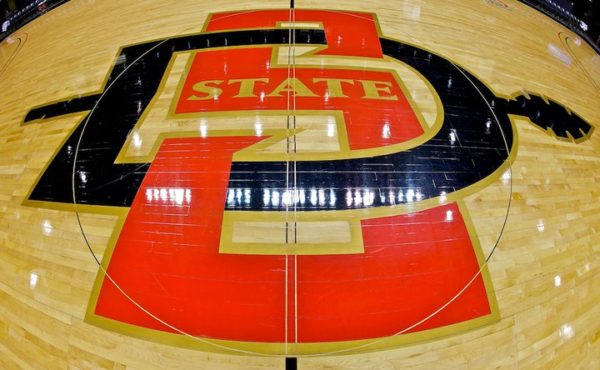2020-21 San Diego State men’s basketball preview

Credit: AP Photo

Five Questions Heading Into the Season
- Who is the Final Starter?
Nathan Mensah has started 33 games in two seasons, including every game he played in last year. Jordan Shakel has started 47 in his career, Matt Mitchell has started 84, and Terrell Gomez started 96 games for Cal State Northridge in three seasons. It is difficult to imagine these four not on the court for tip-off on Wednesday. Who the fifth starter is remains to be seen. There are four viable candidates; each brings positives and negatives.
Aguek Arop: Arop has been called “a swiss-army” knife, a more athletic JJ O’Brien type player whose qualitative impact on the game is felt more than it is calculated. Including Arop in the starting unit creates a matchup nightmare on the offensive end. Arop is only 6’6”; however, his length, athleticism, and skill as an offensive rebounder will force the biggest player not guarding Mensh to cover him, thus opening up the offense for Mitchell and Schakel against smaller players. Defensively, Arop would bring a toughness and ability to guard any position.
On the other hand, Arop’s qualities are precisely those that thrive away from the offensive stars. A put back on an offensive rebound or a steal on defense can be all the offense the second unit needs to produce while the first team rests. Arop’s inclusion would also force Gomez to play the point, a position he has yet to thrive in.
Trey Pulliam: When listing the reasons for his team’s offensive success last year, Coach Dutcher mentioned three players with greater than two to one assist to turnover ratios: Malachi Flynn, Kj Feagin, and Trey Pulliam. Feagin and Flynn are gone, but Pulliam remains. Including him in the starting unit allows Gomez to slide over to the shooting guard. If there were a unit that could most resemble last year’s team after Mensah was hurt, this would be it.
Leaving Pulliam out of the starting unit would keep a steadying, senior influence on the second unit. Pulliam is the only true point guard who is not a freshman, so keeping him in reserve allows for a more balanced rotation. Plus, Pulliam has yet to show enough of an outside game to make a “small ball” unit effective.
Joshua Tomaic: At 6-foot-9, Tomaic is the most traditional choice to insert in the starting lineup. As with Arop, allowing Mitchell to play outside would create matchup issues for opposing defenses. Tomaic is more of a stretch four, so including him in the starting unit would open up the floor for the rest of the team. Place him in the corner, and an opposing big will be taken out of the key, forcing a less agile defender to also play help defense on the wing.
Working against his inclusion is the lack of big men on the Aztec roster. Though used sparingly, Nolan Narain and Joel Mensah were able to spell Yanni Wetzel enough last season. Who other than Tomaic will be able to replace Mensah when he needs to rest, or he gets into foul trouble? Staggering their playing time allows SDSU to have one big man in the game at all times.
Keshad Johnson: With all due respect to Matt Mitchell, Terrell Gomez, and Jordan Schakel, the next NBA draft pick is likely to be Keshad Johnson. Including him in the starting unit is daring him to be great. Reaching the team’s ceiling certainly depends on their sophomore forward, reaching some of his potential sooner rather than later. This would be a pure nod to potential, which is the reason not to include him. Johnson simply has not shown enough to jump the players listed above.
- Who is on the floor to close out games?
More importantly than who starts the game is who finishes it. Mensah has averaged a pair of free throws a game in his career because down the stretch. Coaches did not have confidence in his free throw shooting. Should the coaches change course and include him at the end of the game, expect opposing coaches to test if Mensah is ready to hit clutch free throws. Barring a disaster, Gomez, Schakel, and Mitchell are locks to be closers on the team. Who fills the other two spots on the court?
Option 1: Gomez, Schakel, Mitchell, Pulliam and Mensah
Whether starting or not, expect Pulliam to be given the first shot to close out the game. Running the point allows Gomez to move to shooting guard, where his quickness running off screens is his biggest asset. It would keep opposing coaches up at night devising schemes to stop all of the off-ball movement Dutcher would dream up with the number of shooters on the court late. On the downside, Mensah’s free throw deficiencies might not let him be available. Teams would almost certainly try to force Pulliam to beat them, and he has not proven capable of doing that yet.
Option 2: Gomez, Schakel, Mitchell, Pulliam and Tomaic
Tomaic’s ability to shoot the ball makes this an intriguing unit offensively. With Tomaic away from the basket, the pick and roll between any of the other four would be lethal. Teams would likely switch all screens to prevent the three-ball, so whoever has the ball just needs to be patient to get a favorable one on one matchup. Defensively, this unit could have lots of trouble. When the Aztecs ran this type of group last year, they placed immense pressure on Yanni Wetzel. Can Tomaic play that level of defense when the team’s success depends on him?
Option 3: Gomez, Schakel, Mitchell, another forward and center.
Does the lack of rebounding, defensive presence force the Aztecs to play a bigger unit down the stretch? In this option, Arop, Tomaic, Johnson, or Evans play one forward, while Mensah or Tomaic play the center. If the other units are about risk and reward, this is a very conservative, traditional approach. The Aztecs would limit possessions late by slowing the ball down and playing tremendous defense. Poor free-throw shooting may make this design moot, but playing this way would give more predictable outcomes.
Option 4: Gomez, Schakel, Mitchell, and two forwards
The Aztecs may not be able to get away with playing anyone taller than 6’ 7” for long stretches. Down the stretch, however, could be the perfect time to play small. Imagine a unit with the three senior guards and Arop and Johnson. Arop could play opposing centers for a handful of plays, especially with exotic double teams. Offensively, Arop and Johnson would be monsters on the glass and crashing the basket on the pick and roll. The tempo this unit could play would be extremely fast. Playing a unit for small amounts of time per game is one thing, but waiting to the end is another. This group would have to prove viable earlier in a game to be counted on at the end.
- Can Matt Mitchell play the leading man?
How good is Matt Mitchell? He enters the season as one of the favorites for Mountain West Player of the year. On paper, sliding into the role of leader of the team would be a natural progression, but thriving through that pressure is not for everyone. Mitchell deserves all the credit in the world for selflessly taking a back seat to Flynn last season. He came back to the Mesa this season to play his best basketball as the clear leader of the team. He will have help from several players, but if someone else emerges as the leading man on this team, it will be because Mitchell shrank from the spotlight. Failing to step up in non-conference could result in few resume-building wins. A poor non-conference means the Aztecs will need to win the conference tournament to make the NCAA tournament. To avoid this, the Aztecs will need the best version of Mitchell to date. They will need it as soon as Wednesday against nationally-ranked UCLA.
- Will SDSU hit the Transfer Lottery Again?
Yanni Wetzel, KJ Feagin, and Malachi Flynn will go down as another in a long list of successful SDSU transfers. If Gomez and Tomiac join this group, the Aztecs will be poised to pounce as the NCAA moves towards loosening restrictions on future transfers. Aztec fans should temper their expectations for these two. Gomez, with less than a year to acclimate himself to the program, will likely play more like Feagin than Flynn. Feagin was a high – volume scorer before transferring but rarely showed that form as an Aztec. Flynn may have only played one year in the program, but he practiced for two. Likewise, expecting Tomiac to perform like Wetzel might be wishful thinking. Neither Wetzel nor Tomiac played at their previous school, but usually, when someone does not play, there is a reason, they are not very good. Wetzel breaking that pattern does not change that reality.
- How will the unique schedule impact the year?
A week before the Aztec tip-off, the Governor of California instituted a mandatory curfew for most of the state. As if we needed another reminder, 2020 is not a normal year. Covid could knock out games, practices, and even the season, but even if all games are played, the schedule is as unique as the year it was created in. In order to mitigate the spread of the virus, the Mountain West initiated a new scheduling format this year. Instead of having one home and one road game against most of the conference, SDSU will play a two-game series either at home or on the road with each opponent.
At times, this schedule worked in their favor. Their two games against Boise State, the team picked second in the preseason poll, are both in San Diego. Other times, the schedule is not so favorable. The Aztecs go on the road for four games against the third and fourth place teams, Utah State and UNLV.
The most intriguing part of the schedule is not, however, where they will be played, but the dynamics that change playing a team two games in a row. Game One adjustments are part of the NBA game, but not the college game, until now. Conference opponents are already more familiar with tendency, talent, and tradition, making successful coaching recipes in non-conference, recipes for disaster in conference play. What new dynamics will emerge by playing two games in a row? Teams will not have to wait long to get their revenge after a loss, making season sweeps less likely. The Aztecs should be in a good position to take advantage because when coaching fails to provide an advantage, talent takes over. Top to bottom, SDSU has the most talent in the conference.
My earliest sport’s memory involve tailgating at the Murph, running down the circular exit ramps, and seeing the Padres, Chargers and Aztecs play. As a second generation Aztec, I am passionate about all things SDSU. Other interests include raising my four children, being a great husband and teaching high school.
Excellent preview and breakdown of the season ahead!